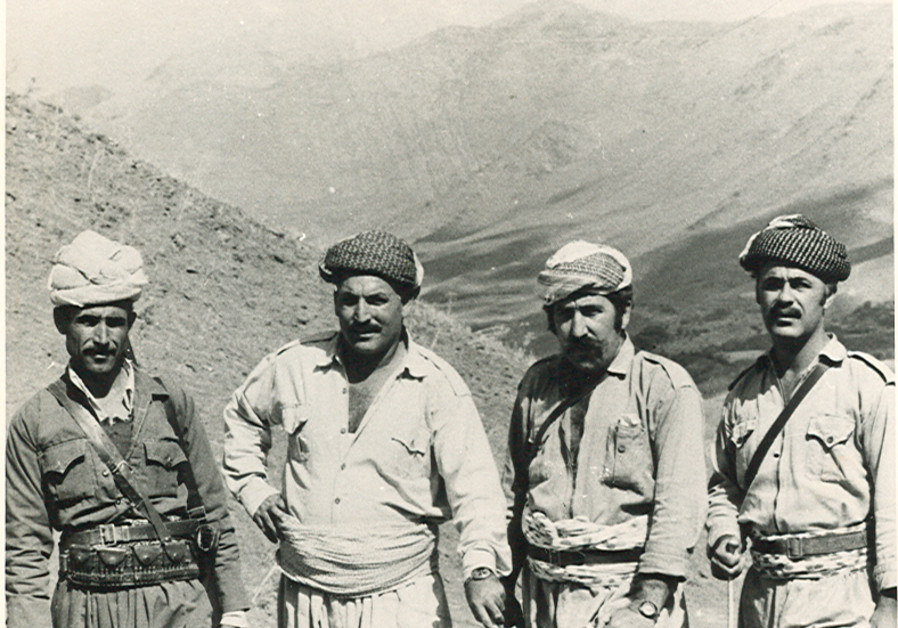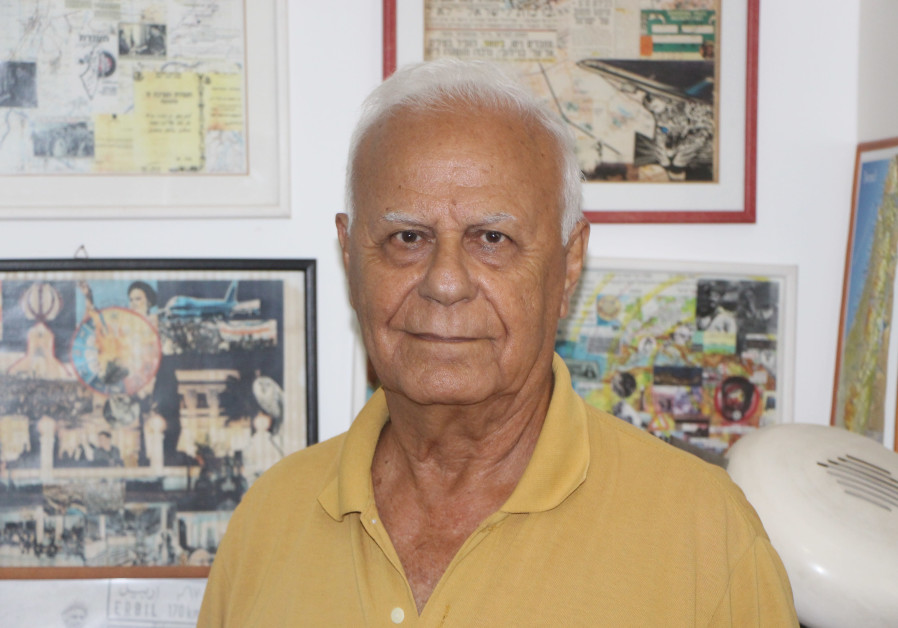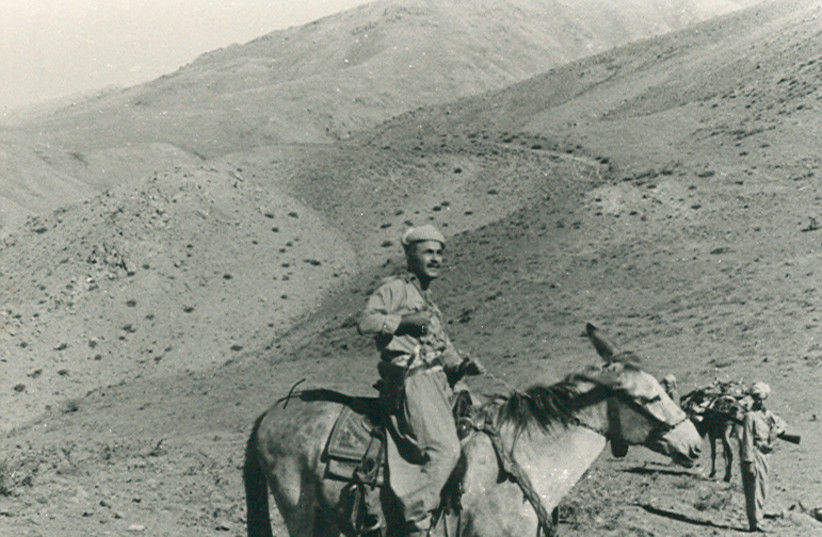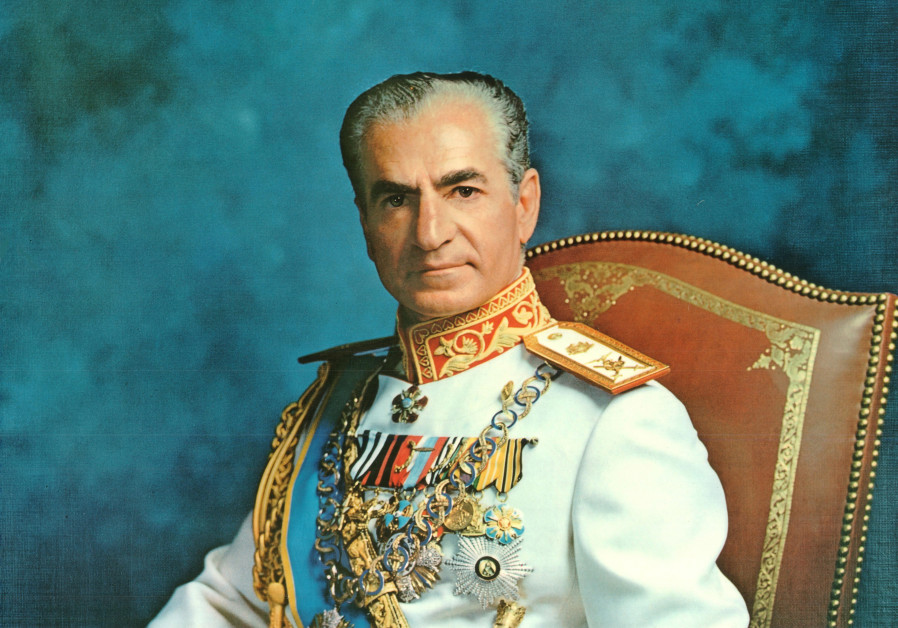A former senior Mossad officer reflects on his service at the cutting edge of Israeli regional strategy
By Jonathan Spyer, JPOST
TSAFRIR ON horseback, northern Iraq mountains, 1974 (photo credit: COURTESY ELIEZER TSAFRIR)
Eliezer “Geizi” Tsafrir, a long-serving officer of the Mossad, was a key field operator throughout Israel’s first four decades.
Tsafrir’s career was focused on two areas of primary importance to the young state: 1) The strategy of the periphery, in which the Jewish state sought to break its isolation in the Middle East by developing relations with non-Arab states in the region – Turkey, Iran and Ethiopia, and 2) the strategy of minorities, whereby Israel sought to make common cause with other non-Arab and/or non-Muslim minority communities in the Middle East.
Tsafrir’s long and varied career began with 12 years at the General Security Service (GSS), Israel’s internal security structure. Joining the fledgling Mossad in 1962, he went on to serve as the head of the organization’s station in Iraqi Kurdistan, the last station chief in Tehran, and the head of the Mossad station in Beirut in 1983-1984. He then served as an adviser on counter-terrorism to prime minister Yitzhak Shamir, retiring in 1992.
Tsafrir is the scion of a Kurdish Jewish family that made its way to then-Ottoman Palestine overland from Iraqi Kurdistan via Syria. On his mother’s side, he is of Moroccan Jewish heritage. His story reflects the enormous benefit Israel derived in its early decades from the presence of Jews hailing from Middle Eastern countries. Their knowledge of the Arabic language and understanding of local cultures were crucial to the development of Israel’s clandestine, extensive and effective strategy in the region in its first decades. The effects and implications of that strategy in turn remain deeply relevant.
A native of Tiberias, and now a sprightly 87-year-old living quietly in a suburb of Tel Aviv, Tsafrir recently sat down with the Magazine to reflect on some of the central aspects of his remarkable career. 
Kurdistan
Eliezer Tsafrir’s first contact with the world of Israeli intelligence did not herald the illustrious things to come. As a 17-year-old counselor in the Gadna (pre-army) program in Tiberias, he recounts, he was called to meet with a senior security official.
“He asked me for information about a particular teacher – was he spreading propaganda among the students, and so on.”
He chuckles at the memory, and shrugs when I ask what he reported.
“The teacher was a communist – but he wasn’t a danger.”
Later, Tsafrir was recruited by the GSS and operated in the Jerusalem area, as the coordinator for a number of Arab villages. He carried out his military service in the framework of the GSS and served with it for 12 years, before he was “poached” by Israel’s nascent foreign intelligence service in 1962.
Serving with distinction in France, Ethiopia and other locations, he was selected to command Israel’s remarkable mission to Iraqi Kurdistan in 1974. Until today, this remains one of the most fascinating largely untold and still-relevant episodes in the history of Israel’s clandestine Middle East diplomacy.
As Tsafrir recalls it, “The Mossad delegation was in Kurdistan for 10 years. The delegation included military advisers and instructors. We supplied [the Iraqi Kurds] with weapons, including artillery, and we conducted courses there – from the section commanders’ course and all the way to the course for battalion commanders.”
The Mossad presence in Kurdish northern Iraq was logistically dependent on Israel’s then-excellent relations with Iran.
“People would fly to Tehran, and then with the help of the Savak [the pre-revolutionary Iranian intelligence service], they would enter the Kurdish territory.”
The Israeli presence was the result of the close relations forged with Mulla Mustafa Barzani, grandfather of current Iraqi Kurdish President Nechirvan Barzani. Tsafrir arrived to command the mission in 1974. But from headquarters, he had already witnessed the benefits this connection had brought to Israel.
“In 1970-1971, we had used the assistance of the Kurds to get 1,300 Jews out of Baghdad. From there to the Kurdish area, and then to Iran, where the Jewish Agency was waiting to bring them to Israel. I was head of the department at HQ dealing with this.”<
In 1974, then-Mossad head Zvi Zamir proposed to Tsafrir that he take up the leadership of the delegation in northern Iraq. His appointment was meant to last two years.
The benefits accruing to Israel from this mission were not solely in the field of Jewish immigration to Israel. Rather, the main purpose in return for the assistance given to Kurdish fighters was to gather intelligence, particularly on the Iraqi army.
“Iraq sent to every war against us a division, sometimes two divisions,” says Tsafrir. “Our interest was in an intelligence window, also by way of Kurdish officers who were officers in the Iraqi army. We activated them, also in the area of recruitment of agents, in order to achieve ‘coverage’ of the Iraqi Army.”
Tsafrir’s posting, however, proved shorter than planned. The complex and shifting geopolitics of the region were the reason for its curtailing.
The Israeli presence in northern Iraq was made possible because of a dispute between the Shah’s Iran and Ba’athist Iraq over access to the Shatt al-Arab waterway. In 1975 this dispute was resolved with the signing of an agreement in Algiers. The result had an immediate effect.
“The Shah [Mohammad Reza Pahlavi] ordered the Savak chief and the chief of staff to remove all Iranian forces assisting the Kurds in Iraq. They had mortar battalions in there, artillery batteries and anti-aircraft, to protect the house of Barzani.”
This equipment was removed overnight. Tsafrir, meanwhile, “stayed there alone. Just me and my assistant, the only foreigners in Kurdistan. And the Iraqi Army began a strike attack on the area where we were located.”
A British journalist covering Iraq at the time, Patrick Brogan, described the Iraqi offensive in the following terms: “The Iraqis celebrated their victory in the usual manner – by executing as many of the rebels as they could lay their hands on.”>
“If they had reached us, they would have made us into shashlik – or maybe kebab,” Tsafrir laughs. “So I had to get out of there fast, by way of Iran. There was a danger that the Iraqis might close off the border crossings. That happened afterwards – but I got out in time.”
The forced withdrawal of the Israeli mission from Iraqi Kurdistan remains a subject of controversy and contention among Iraqi Kurds to this day, as this author discovered on many occasions reporting in the area. According to Tsafrir, however, the withdrawal did not mark the end of the clandestine Israeli relationship with the Kurds, and with the Barzani family in particular.
“The connection with the Barzanis continued, at a lower volume through the years, and until today,” he tells me.
“Sometimes we had a representative who would come and go. In later years I myself went a few times. Via Istanbul, to Diyarbakir, and from there the Turkish MIT [intelligence service] would take me to the border and the Barzani guys would be waiting for me.”
Tsafrir’s own Kurdish heritage is evident in the passion with which he speaks of their cause, as he sums up his work in this area.
“The Kurds want a state. Not just the Kurds in Iraq – in Iran also, and Turkey and Syria. That’s the tragedy. There are 40 million Kurds, who have not yet arrived to where they need to get. It’s a stain on the conscience of the world.”
IRANIAN SHAH Mohammad Reza Pahlavi, of?cial portrait, 1973: Unusual request. (Credit: Wikimedia Commons)
Iran
After his work in Iraqi Kurdistan, Tsafrir was appointed to head the Mossad station in Tehran. In 1978, as the internal situation in Iran worsened, he found himself turning from joint work with his Iranian colleagues, to observation and analysis of unrest within Iran itself.
“We had excellent relations with the Savak, and with Iranian military intelligence – including the operating of agents within Iraq and within the Palestinian terror groups. Then the demonstrations began, and I suddenly found myself needing to gather intelligence on Iran, and on the Shah himself – and the extent of his determination to continue in power against the pressure that [then US-president Jimmy] Carter was placing on him.”
With the unrest building in Iran, the Mossad also sought to open channels of communication with the revolutionary forces in the country. The picture that emerged was not encouraging.
“I managed to talk with sane elements in the opposition, but it was difficult. And the elements around [future Iranian revolution leader Ayatollah] Khomeini were of course deeply hostile. As the situation worsened, [then-senior Mossad official] Dave Kimche and I met with a senior figure from the secular opposition, whose wife was Jewish, by the way. He said to us openly, ‘Forget logic in what is going on in Iran. Clear thinking has gone. For two or three years, there’s nothing to talk about.’ He was in despair.”
The issue of the safety of Israeli diplomats and other citizens in Iran emerged as the Islamic revolution drew near. A Savak official was appointed to report to Tsafrir, so that appropriate measures could be taken for the evacuation of the Israelis.<
Then, in October 1978, with riots and demonstrations spreading across the country, Mossad station chief Tsafrir was called for a meeting with the Shah, to hear an unusual request.
“A man from the Savak came to me and said, ‘Put on your jacket and tie, you’re going to meet the Shah, the king of kings. And you will hear from him a request: that the Mossad kill Khomeini in Paris.’”
The request was duly conveyed.
“I knew what the answer would be. But I said that I would need to consult with headquarters. I asked, and I got the expected answer. So I said to the Iranians, we aren’t your police, we aren’t the police of the world – if there’s a problem, you should do what’s needed. Later, I learned that the French foreign secretary had visited Tehran two weeks earlier and had said to the Shah, ‘If there’s something you need to do in Paris, we’ll look the other way.’ And then the Shah thought about it and came to us.”
Reflecting 40 years later, Tsafrir says, “In retrospect, I regret it. We could have saved the whole Iranian nation from this situation and Israel from the nuclear threat.”
In the last half of 1978, Tsafrir worked on quietly evacuating the 1,300 Israeli citizens then present in Iran. By November, only 300 remained. After the offices of El Al were attacked and ransacked, the Mossad chartered two El Al planes and a further 270 Israelis were evacuated, leaving just over 30 citizens remaining.
The end, in February 1979, was sudden.
“The whole city was in chaos. People with AK-47s, shooting in the streets… a great crowd descended on the Israeli Embassy, which was no longer operating. And we saw on the roof a PLO flag, with Ahmed Khomeini, the son of the Ayatollah there, and Hani al-Hassan, the PLO representative in Tehran. And that was the end of the embassy. Afterwards it became the PLO office.”
Tsafrir and the Mossad station were responsible for coordinating the evacuation of the remaining Israelis.
“I saw that they put all the Israelis in the Hilton. And with the cooperation of the US military attache, I made sure everyone was there. Defense minister Ezer Weizman called the US defense secretary and got a commitment that all 34 Israelis would leave on the first US flight out. So we got them from the Hilton on a bus to the airport, and that was that.”
Tsafrir himself left Iran with this group.
“Thirty-four Israelis left – but there was a Jewish community of 84,000 still remaining. We couldn’t interfere, but we brought as many EL Al planes as possible, so that as many as possible could leave. There was a guy called Tzion Bar Yitzhak – afterwards I recommended that he light a torch on Independence Day – and he went around all the communities, not only in Tehran, and explained how if they wanted to leave, to get to El Al and so on, and large numbers left. After the revolution we continued from Europe activating contacts to get Jews out, using smugglers.”
Regarding the current situation in Iran, his views are stark and unequivocal. Tsafrir sees the current Iranian regime as motivated primarily by religious ideology and doctrine. He is clear as to the appropriate response.
“Iran is pursuing a policy to obtain nuclear weapons. If they achieve it, they will use these weapons against us. And so it is forbidden that this should happen. They ask me at the highest levels, as one who knows Iran, if they have nuclear weapons, will they use this capability against us. I respond that they would. We are the chief target for Iran. [Mahmoud] Ahmadinejad, when he was president, prepared a gate in Qom for the coming of the Mahdi [an eschatological messianic figure]. There is an insanity there of extremism and hatred of Israel.”
Tsafrir is in favor of preemptive air action against Iran’s nuclear facilities.

Later years
After Iran, Tsafrir served for three years in Latin America (“looking for [infamous Nazi doctor Josef] Mengele and working with young people in the communities there to develop defense for community institutions”). Then in 1983-1984, he served as chief of the Mossad station in Beirut, at the height of Israel’s alliance with the Christian Lebanese Forces. This was also the period of the Iranian efforts at organization that would result in the emergence of Hezbollah. He is less forthcoming on this period, noting drily, “Many Israelis thought the Lebanese Forces would do something for themselves. They, meanwhile, thought that Israel was a superpower.”
Tsafrir’s final appointment was as an adviser to prime minister Yitzhak Shamir. He retired from the Mossad in 1992.
In the subsequent years, he has written three books about his work and experiences. None have yet appeared in English.
Tsafrir’s study in his quiet apartment north of Tel Aviv is decorated with mementos from his time working in the region.
Here is Tsafrir with Iraqi Kurdish leader Massoud Barzani, there is a portrait of Lebanese Forces leader Bashir Gemayel. And there is a grainy black and white picture of some Peshmerga banquet in the 1970s, perhaps at Mullah Mostafa Barzani’s home in Haj Umran. One can make out Tsafrir there, almost indistinguishable from the Kurds, moustached and head-dressed, and on the other side of the table, unmistakable, Zvi Zamir, the head of the Mossad at the time. Artifacts from a long life dedicated at once to Israel’s security, the safety of Jewish communities and to something else: namely, the ongoing attempt to locate Israel within a framework of alliances, relations and connections in the Middle East itself.
This, of course, is a task that is not yet completed. It has advanced considerably in recent years. The career of Eliezer “Geizi” Tsafrir, conducted far from the comfortable halls of formal diplomacy, has a notable share in this achievement.





A very relevant tale by a pioneer of the State’s intelligence community. He offers a context on many matters relating to many struggles undertaken during his career. Well worth the read.